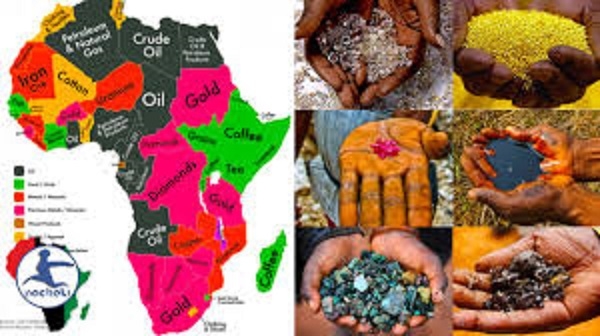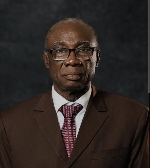Africa’s natural resources: Who’s after what and what’s the continent’s strategy in the scramble game?
 Africa'snatural resources
Africa'snatural resources
Africa is home to abundant natural resources: water bodies, arable land, agricultural produce, mineral and human resources, not to mention the continent’s God-given rich and diverse culture.
The continent is a treasure trove of natural wealth, holding about 30% of the world’s mineral reserves, eight percent of its natural gas, and 12% of its oil, according to the UN Environment Programme.
Africa is rich in gold, housing 40% of the global supply of the metal.
The continent is rich in chromium and platinum, holding up to 90% of the world’s reserves. It’s also home to the largest deposits of cobalt, diamond, platinum, and uranium.

Beyond minerals, Africa’s agricultural potential is immense, with 65% of the world’s arable land and 10% of the planet’s renewable freshwater.
This land is not only a key driver for economic development but also holds deep socio-cultural significance for the people who live there.
In sub-Saharan Africa, over 70% of the population relies on forests and woodlands for their daily needs, highlighting the critical role of these resources in their lives.
Natural resources form a significant part of national wealth in many African countries, accounting for 30% to 50% of their total wealth. Yet, much of this natural capital is being depleted through unsustainable practices and illegal activities.
Annually, Africa loses an estimated $195 billion due to illicit financial flows, illegal mining, logging, wildlife trade, unregulated fishing, and environmental degradation.
These losses reduce the benefits that these resources can provide over time, posing a serious challenge to sustainable development, the UN Environment Programme warns.
A 2022 article by Aljazeera titled: ‘Mapping Africa’s natural resources’ notes that petroleum and coal are incredibly abundant in 22 of Africa’s 54 countries.
The report said as of 2019, Nigeria led in petroleum production, contributing 25% of the continent’s output, with Angola (17%) and Algeria (16%) following close behind.
When it comes to metals like gold, iron, titanium, zinc, and copper, 11 African countries prioritise their production. Ghana stands as the largest gold producer on the continent, with South Africa and Mali also achieving significant levels of productions.
Industrial minerals, including diamonds, gypsum, salt, sulfur, and phosphates, are the primary commodities for 13 African countries.
The Democratic Republic of Congo (DRC) is the top producer of industrial diamonds in Africa, followed by Botswana and South Africa. Notably, Botswana is renowned for its gem-quality diamonds, which are highly prized in the jewellery market.
In 2019, in terms of numbers, South Africa led the continent in generating revenue from mineral resources, raking in $125 billion annually. Nigeria follows with $53 billion, then Algeria with $39 billion, Angola with $32 billion, and Libya with $27 billion.
These five countries collectively account for more than two-thirds of Africa’s mineral wealth.
The others include Egypt ($23bn), Ghana ($15bn), Democratic Republic of Congo ($14bn), Gabon ($11bn) and Zimbabwe ($10). These figures compiled by Aljazeera, excluded the numbers for diamonds.
The World Mining Congress reported that around 17.9 billion tonnes of minerals were extracted globally in the same year.
Asia dominated the scene, producing 59% of the total, valued at $1.8 trillion. North America and Europe followed with 16% and 7% respectively.
Africa produced about 5.5% of the world’s minerals, valued at approximately $406 billion.
The Major Natural Resources Of Each African Country According To The US Geological Survey And CIA World Factbook:
North Africa
1. Algeria: Petroleum, natural gas, iron ore, phosphates, uranium, lead, zinc
2. Egypt: Oil, natural gas, phosphates, iron ore, manganese, limestone, gypsum, talc, asbestos, lead, rare earth elements, zinc
3. Libya: Petroleum, natural gas, gypsum
4. Morocco: Phosphates, lead, zinc, iron ore, manganese, copper, silver, fish
5. Tunisia: Petroleum, phosphates, iron ore, lead, zinc, salt
West Africa
1. Benin: Small offshore oil deposits, limestone, marble, timber
2. Burkina Faso: Gold, manganese, limestone, marble, phosphates, pumice, salt
3. Cape Verde: Salt, basalt rock, limestone, kaolin, fish
4. Côte d’Ivoire (Ivory Coast): Petroleum, natural gas, diamonds, manganese, iron ore, cobalt, bauxite, copper, gold, nickel, tantalum, silica sand, clay, hydropower
5. Gambia: Fish, clay, silica sand, titanium, tin, zircon
6. Ghana: Gold, diamond, manganese, bauxite, oil, silver, salt, limestone
7. Guinea: Bauxite, iron ore, diamonds, gold, uranium, hydropower, fish
8. Guinea-Bissau: Fish, timber, phosphates, bauxite, clay, granite, limestone
9. Liberia: Iron ore, timber, diamonds, gold, hydropower
10. Mali: Gold, phosphates, kaolin, salt, limestone, uranium, hydropower
11. Mauritania: Iron ore, gypsum, copper, phosphates, diamonds, gold, oil, fish
12. Niger: Uranium, coal, iron ore, tin, phosphates, gold, molybdenum, gypsum, salt, petroleum
13. Nigeria: Petroleum, natural gas, tin, columbite, iron ore, coal, limestone, niobium, lead, zinc, gold
14. Senegal: Fish, phosphates, limestone, gold, iron ore
15. Sierra Leone: Diamonds, titanium ore, bauxite, iron ore, gold, chromite
16. Togo: Phosphates, limestone, marble, arable land
Central Africa
1. Angola: Petroleum, diamonds, iron ore, phosphates, copper, feldspar, gold, bauxite, uranium
2. Cameroon: Petroleum, bauxite, iron ore, timber, hydropower
3. Central African Republic: Diamonds, uranium, timber, gold, oil, hydropower
4. Chad: Petroleum, uranium, natron, kaolin, fish (Lake Chad)
5. Congo (Brazzaville): Petroleum, timber, potash, lead, zinc, uranium, copper, phosphates, gold, magnesium, natural gas
6. Democratic Republic of the Congo (Kinshasa): Cobalt, copper, diamond, coltan, zinc, tin, gold, tungsten
7. Equatorial Guinea: Petroleum, natural gas, timber, gold, bauxite, diamonds, tantalum, sand and gravel, clay
8. Gabon: Petroleum, manganese, uranium, gold, timber, iron ore, hydropower
East Africa
1. Burundi: Nickel, uranium, rare earth elements, copper, platinum, vanadium, arable land
2. Comoros: Fish, natural gas
3. Djibouti: Geothermal energy, gold, clay, granite, limestone, marble, salt, diatomite, gypsum, pumice
4. Eritrea: Gold, copper, potash, zinc, natural gas, oil, fish, salt
5. Ethiopia: Gold, platinum, copper, potash, natural gas, hydropower
6. Kenya: Limestone, soda ash, salt, gemstones, fluorspar, zinc, diatomite, gypsum, wildlife, hydropower
7. Madagascar: Graphite, chromite, coal, bauxite, rare earth elements, salt, quartz, tar sands, semiprecious stones, mica, fish, hydropower
8. Malawi: Limestone, arable land, hydropower, unexploited deposits of uranium, coal, and rare earth minerals
9. Mauritius: Fish, arable land
10. Mozambique: Coal, titanium, natural gas, hydropower, tantalum, graphite
11. Rwanda: Gold, cassiterite (tin ore), wolframite (tungsten ore), methane, hydropower
12. Seychelles: Fish, coconuts (copra), cinnamon trees
13. Somalia: Uranium, iron ore, tin, gypsum, bauxite, copper, salt, natural gas
14. South Sudan: Petroleum, iron ore, copper, chromium ore, zinc, tungsten, mica, silver, gold, hydropower
15. Tanzania: Gold, diamonds, gemstones, iron ore, coal, uranium, nickel, chrome, tin, platinum, coltan, niobium, natural gas
16. Uganda: Copper, cobalt, hydropower, limestone, salt, arable land, gold
US interest in Africa’s natural resources
The United States imports a substantial amount of natural mineral resources from Africa each year, focusing on several key minerals and metals. Based on the latest data from 2022 and 2023, here are some figures:
Petroleum and Natural Gas: The U.S. imports significant amounts of crude oil from African countries, primarily Nigeria and Angola. In 2021, Nigeria alone exported approximately 200,000 barrels per day to the U.S. (USGS Publications) (United States International Trade Commission (USITC)).
Gem-Quality Diamonds: The U.S. is a major importer of diamonds, mostly from South Africa. In 2021, the import value of non-industrial (gem-quality) diamonds from South Africa increased by 110.9% to $537 million (USITC).
Cobalt and Copper: The Democratic Republic of the Congo (DRC) is a major supplier of cobalt and copper. The U.S. imports a significant amount of cobalt, which is crucial for the production of batteries, especially for electric vehicles. The import of copper cathodes also saw a significant rise, reflecting the demand in various sectors such as construction and green technologies (USITC).
Platinum Group Metals (PGMs): South Africa is a leading exporter of PGMs, which are vital for automotive catalytic converters, electronics, and jewellery. The U.S. imports a significant portion of these metals from South Africa to meet its industrial and manufacturing needs (USGS Publications).
Rare Earth Elements and Industrial Minerals: African countries like Madagascar and South Africa supply rare earth elements and industrial minerals such as titanium and manganese. These imports are critical for various high-tech applications and steel production (USGS Publications) (USITC).
In 2021, the total value of minerals and metals imported by the U.S. from Africa was significant, with the import of gemstones alone reaching $22.2 billion, reflecting a broad demand for both industrial and non-industrial minerals (USITC).
These imports highlight the strategic importance of African mineral resources to the U.S. economy, particularly in supporting technology, energy, and manufacturing sectors.
The data also underscores the growing trend of increasing import volumes and values, driven by higher global prices and rising demand in various downstream industries.
China And Asia’s Interest in the Natural Resource Interests Of Africa
China is a significant importer of natural mineral resources from Africa, with imports valued at approximately $10 billion from sub-Saharan Africa in 2019 alone (United States Institute of Peace).
The range of minerals imported includes critical resources such as cobalt, lithium, copper, and iron ore, which are vital for various industries, particularly in the manufacturing of modern technologies (Council on Foreign Relations) (SpringerLink).
In 2022, China-Africa trade reached $261 billion, marking a substantial rebound from the previous year’s disruptions due to the COVID-19 pandemic (China Africa Research Initiative).
This trade includes a large proportion of minerals and metals, with Angola, the Democratic Republic of Congo (DRC), and South Africa being the largest exporters to China.
These exports primarily consist of mineral fuels, lubricants, and various other mineral commodities (China Africa Research Initiative).
Chinese investment in Africa’s mining and mineral sectors is also extensive, and worth billions of dollars. This investment often takes the form of loans, Chinese government-funded development projects and equity ownership in mining operations across the continent.
This strategic investment helps secure China’s access to these crucial resources while also contributing to infrastructure development in Africa (Council on Foreign Relations) (SpringerLink).
Other Asian countries like India and Japan also engage in significant trade with Africa. India imports large quantities of crude oil from African nations such as Nigeria and Angola, while Japan imports minerals and metals vital for its manufacturing sector.
Overall, Asia’s demand for Africa’s natural resources continues to grow, driven by the need for energy and raw materials to support its expanding economies (Atlantic Council).
China’s strategy in Africa has thankfully, evolved from merely extracting the continent’s natural resources to investing in infrastructure and industrial projects that facilitate easier trade and development.
This shift aims to create a more sustainable and mutually beneficial economic relationship (Asia Times).
The EU’s Interests in Africa’s Natural Resources.
The European Union (EU) imports a significant quantity of natural resources from Africa annually, playing a crucial role in Europe’s supply chain for critical raw materials and energy resources.
Key Imports and Their Sources
1. Natural Gas:
Algeria and Nigeria are major suppliers of natural gas to the EU. Algeria exports significant volumes via pipelines, while Nigeria mainly supplies liquefied natural gas (LNG). These imports are critical for the EU, especially in the context of reducing reliance on Russian gas (Natural Resource Governance Institute).2. Critical Raw Materials:
Africa is a key supplier of several critical raw materials (CRMs) needed for various strategic technologies in the EU, such as renewable energy technologies, electric vehicles, and digital infrastructure. These materials include cobalt, manganese, and rare earth elements, with significant portions sourced from countries like the Democratic Republic of Congo (cobalt) and South Africa (manganese and platinum group metals) (Internal Market SMEs).3. Oil:
Several African countries, including Nigeria, Angola, and Libya, export crude oil to the EU. These imports are vital for the EU’s energy needs, although the EU is working towards reducing overall fossil fuel dependency as part of its Green Deal objectives (Natural Resource Governance Institute).Volume and Economic Impact
• The EU’s imports of natural resources from Africa are substantial, with natural gas imports alone amounting to several billion cubic meters annually. For example, Algeria supplied around 10% of the EU’s total gas imports in recent years (Natural Resource Governance Institute).
• In terms of economic impact, the value of these imports runs into billions of euros, significantly contributing to the economies of the exporting African countries while ensuring the stability of the EU’s supply chains (Internal Market SMEs) (Natural Resource Governance Institute).
The EU’s strategy of diversifying its energy sources away from Russia has led to increased engagement with African suppliers. However, this relationship is not just about securing immediate supply but also involves long-term commitments to sustainable and fair trade practices. The EU is keen on promoting renewable energy projects in Africa, which can help African countries transition to greener economies while ensuring the EU’s access to essential resources (Natural Resource Governance Institute).
Russia’s Interests in Africa’s Natural Resources
Russia’s import of natural mineral resources from Africa, while significant, is relatively modest compared to imports by other global players in the mineral’s industry such as China and the European Union. In 2021, Russia’s trade with African countries amounted to approximately $18 billion, with a focus on critical minerals such as gold, diamonds, uranium, and oil (Council on Foreign Relations).
Russian companies actively engage in the extraction and trade of several key minerals from Africa. For instance, Russia imports substantial quantities of gold and diamonds from countries like the Democratic Republic of Congo (DRC) and Angola. The presence of Russian private military companies, such as the Wagner Group, in countries like Sudan, the Central African Republic (CAR), and Libya, further underscores Russia’s strategic interest in securing access to these valuable resources (Council on Foreign Relations) (Valdai Club).
Despite these efforts, Russia’s share of the African mineral market remains relatively small compared to other major importers.
For instance, Russia’s imports of mineral fuels and oils, which constitute a significant portion of its trade, come primarily from countries outside Africa.
In 2021, Russia’s import structure was dominated by commodities like nuclear reactors, machinery, and vehicles, with mineral resources from Africa playing a secondary role (TrendEconomy).
Overall, while Russia is actively involved in the African mineral sector, its imports are limited when compared to its broader trade activities with other regions.
The strategic engagements and partnerships formed in Africa, however, highlight the continent’s importance to Russia’s long-term economic and geopolitical strategies.
Saudi Arabia and the Middle East’s Interests In Africa’s Natural Resources
The Middle East, particularly Saudi Arabia, imports a significant quantity of natural resources from Africa, focusing primarily on hydrocarbons and minerals.
These imports play a crucial role in the region’s economic growth and diversification efforts.
Saudi Arabia is a major importer of African minerals and hydrocarbons. Saudi Arabia has been actively investing in mining and acquiring mineral resources on the continent to support its industrial and technological development.
For instance, the Democratic Republic of Congo (DRC), a key African exporter, supplies substantial quantities of cobalt, which is crucial for electric vehicle (EV) batteries and other high-tech industries.
Additionally, Saudi Arabia’s mining giant, Ma’aden, has been involved in partnerships to explore and develop critical mineral reserves in Africa (Middle East Institute) (Oxford Business Group).
The Middle East’s demand for these resources is driven by several factors.
One major driver is the region’s commitment to diversifying its economy and reducing its dependence on oil through initiatives like Saudi Arabia’s Vision 2030.
This plan emphasises the development of the mining sector and seeks to attract private investments into underexplored regions and adopt environmentally sustainable extraction methods (Oxford Business Group).
The region’s import patterns also reflect its strategic interests in ensuring a reliable supply of critical minerals necessary for clean energy technologies.
These include materials for solar panels, wind turbines, and other renewable energy infrastructure, which require several times more minerals than their fossil fuel-based counterparts (Middle East Institute).
Analysis
From the above, it is clear why Russia’s and China’s increased engagement with Africa is of such great concern to the United States and other countries in the West. Lately, Saudi Arabia and Qatar have joined the mix.
The US and the EU no doubt wish they could have exclusive access to Africa’s natural resources in a continual neo-colonialist fashion by dictating the terms and conditions of their trade relations with Africa.
Russia and China, on the other hand, deal with Africa from a point of mutual respect, true friendship and fair trade partnership predicated on give-and-take principle, and not subtle exploitation intended to micromanage the continent’s economic affairs.
The economic incursion on Africa by these geopolitical powers is like a chess game where China, Russia and the Middle Eastern countries are a sort of a tag team on one side battling the US and Europe on the other side.
Africa, on the other hand, appears to be a passive economic and political playground for these powers. Through trade and world politics, Russia is seeking to break the US-imposed bipolarity on the rest of the world.
Therefore, even though Putin’s trade with Africa may have an ulterior motive, the diversity of partnership that it presents to Africa is of utmost importance to the continent since decades of trading with the US and Europe has been lopsided against the continent and somewhat a master-slave relationship.
Just like Russia, China is also seeking its interest by employing a different strategy – debt trap.
It sinks so much into African countries in terms of loans until the quantum chokes the beneficiaries, forcing them to vomit all their natural resources at the feet of their benefactor.
Africa has a lot to offer the world.
How it strategically takes advantage of the scramble for its natural wealth must be of the utmost importance to the continent and its leaders.
Since it is a matter of good governance and economic growth and development of their countries, these leaders cannot continue to act as if it were business as usual.
Every economic interest everywhere in the world today has sights on the natural wealth of Africa and is either devising or has already devised a strategy to milk the continent’s natural resources dry for their economic and political benefit.
Africa must not be the only nonchalant and random planner and actor in its engagement with the rest of the world concerning its own natural resources.
Allowing bad leadership and corruption to continue to maintain the exploitative status quo would be a horrendous crime against future generations of the continent’s people.
Russia, China, the US, EU and the Middle East are scrambling for Africa’s natural resources because they have projected a dearth of those materials in the coming decades and, thus, are strategising to secure as much of it as they can, in store for their future generations.
Africa – the stage for the play – must not and cannot remain passive in this game
Source: cisanewsletter.com
Trending Features

Is the Special Prosecutor independent?
00:57
Africa’s Bold Stand: Mali’s victory and Ghana’s resolve should be the blueprint
13:50
In defence of Act 794: Context, competitiveness and the real path to mining value
13:59
KGL's Resilience, impact in 2025 a remarkable benchmark for corporate Ghana
09:06
Is Ghana’s Special Prosecutor truly independent? Legal analysis raises key questions
14:39



